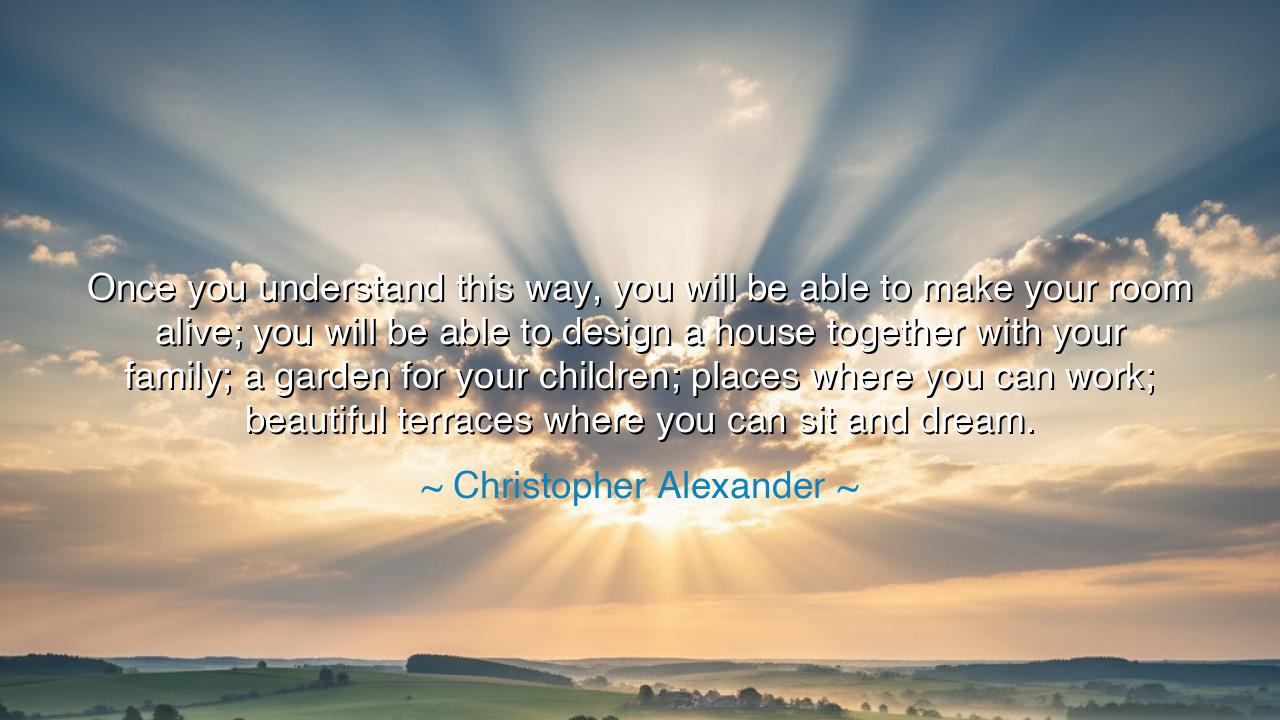
Once you understand this way, you will be able to make your room
Once you understand this way, you will be able to make your room alive; you will be able to design a house together with your family; a garden for your children; places where you can work; beautiful terraces where you can sit and dream.






The words of Christopher Alexander—“Once you understand this way, you will be able to make your room alive; you will be able to design a house together with your family; a garden for your children; places where you can work; beautiful terraces where you can sit and dream”—are not merely the reflections of an architect, but the teachings of a philosopher-builder, a man who believed that the essence of design is life itself. In this gentle yet profound vision, Alexander reveals a truth that transcends architecture: that our spaces—the rooms, the gardens, the corners of our daily existence—are mirrors of our souls, and when shaped with love and understanding, they awaken something sacred within us.
To “understand this way,” as he says, is not to learn the mechanics of construction, nor the trends of style, but to grasp the living pattern of harmony that connects the human heart to the physical world. Alexander, in his life’s work—especially in his writings such as The Timeless Way of Building—spoke of a universal order that breathes through all things. He called it the “quality without a name”, that ineffable sense of rightness one feels in a well-loved home or a sunlit courtyard. When a place is made with care, humility, and attention to life, it becomes more than shelter—it becomes alive.
To make your room alive, then, is an act of creation equal to any art or prayer. It is to infuse one’s surroundings with warmth, purpose, and soul. The ancients understood this instinctively. The builders of the old villages in Greece, the craftsmen of Japan, the masons of medieval Europe—all shaped their homes not from blueprints, but from relationship: the way sunlight entered a window, the rhythm of footsteps across a courtyard, the laughter of a family gathering at dusk. Their houses grew like living organisms, responding to the needs of the people and the spirit of the land. In them, architecture was an act of love.
One might recall the story of Frank Lloyd Wright designing the home of his client, the Kaufmann family—what became known as Fallingwater. Wright did not impose upon the land but listened to it. He built above the waterfall not to dominate nature, but to dwell within its sound. The home became alive because it was in conversation with its surroundings. This is the same truth Alexander teaches: that a house should grow from the heart outward, that design should be a dialogue between life and form. When this happens, walls cease to confine—they begin to embrace.
But Alexander’s words reach beyond architecture. They speak to the building of life itself. To design a house together with your family is to practice unity; to plant a garden for your children is to invest in hope; to make beautiful terraces where you can sit and dream is to honor rest, imagination, and wonder. Each act of creation becomes a reflection of the greater work of being human—the art of weaving meaning into the fabric of the everyday. To live this way is to become a builder not only of spaces, but of peace.
His message also carries a quiet rebellion against the lifelessness of modernity. In a world of prefabricated houses and empty design, Alexander reminds us that true beauty cannot be mass-produced. The living quality of a place arises from presence—when hands build with care, when families shape their homes through shared memory, when design serves not ego but life. It is the difference between a house that shelters and a home that sings.
Let this, then, be the teaching for all who build, whether of wood, of stone, or of time itself: build with life in mind. When you arrange your home, do not think first of fashion or function, but of feeling. Ask what makes your heart quiet, what gives your children joy, what awakens your soul at dawn. A single window placed with intention is worth more than a hundred walls without love. Cultivate your spaces as you would a garden—with patience, with wonder, with care.
For in the end, Christopher Alexander teaches us that to build is to love, and to love is to give form to life. When your room feels alive, when your garden blooms with laughter, when your terrace welcomes both dreams and dawns, then you have touched the timeless art he speaks of. In this way, the builder and the poet, the parent and the child, all become one: makers of living beauty, shaping not just houses—but sanctuaries for the human spirit.






AAdministratorAdministrator
Welcome, honored guests. Please leave a comment, we will respond soon